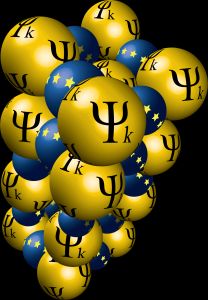Invited speakers
Emilio Artacho
Nanogune, Spain, and University of Cambridge, UK
Electronic stopping power from first principles - Recent results for slow protons and antiprotons in LiFAbstract
G. Massillon-JL, A. A. Correa, X. Andrade & E Artacho
Electronic stopping power (ESP) gives the rate of energy transfer from a projectile particle motion to the target electrons of the matter it traverses.Real-time time-dependent density-functional-theory calculations (RT-TDDFT) give access to ESP in regimes where other approximations are not quite suitable. In particular, for the onset of non-adiabaticity in insulators, it is quite generally accepted that insulators display a velocity threshold below which ESP is negligible. ESP is also expected to be larger for positively charged projectiles than for their negative antiparticles. Both facts have been recently challenged in first-principles calculations of ESP for protons and antiprotons in LiF [Qi, Bruneval and Maliyov, Phys. Rev. Lett. 128, 043401 (2022)]: the threshold seems to effectively disappear for antiprotons while remaining well defined for protons, the latter fact being consistent with experiments. In our own first-principles calculations we reproduce their results in the same [111] channelling conditions they used. We explain the phenomenon by a mid-gap level appearing for antiprotons, which effectively oscillates approaching the conduction band as the antiproton moves, fitting well to an elevator effect [A. Lim, et al., Phys. Rev. Lett. 116, 043201 (2016)]. However, the effect disappears for other directions of propagation, and washes out when averaging, recovering both the threshold and the expected Barkas effect, and therefore predicting an important sensitivity of ESP to experimental setup (unidirectional controlled channelling vs otherwise) for low velocities.
G. Massillon-JL, A. A. Correa, X. Andrade & E Artacho, Phys. Rev. Lett. 134, 076401 (2025); arXiv:2501.14381Laurent Karim Béland
Queen's University, Canada
Electron-ion effects on primary damage production in zirconiumAbstract
Zirconium is commonly used as a structural and fuel cladding material in the nuclear power sector, which explains why many have studied primary damage production by high-energy collisions in Zr. Most of these studies have ignored electron-ion effects. A few treated them by applying a friction force to the ions, while one study employed a two-temperature model where electron stopping and electron-phonon coupling are treated separately. Herein, we present collision cascade simulations in Zr with primary knock-on atom kinetic energies varying between 10 keV and 40 keV, where electron-ion effects are taken into account using a unified two-temperature model, where electron stopping and electron-phonon coupling are treated jointly. Three different interatomic interaction potentials were considered. We found that electron-ion effects are potential-dependent. Either electron-ion effects had little impact on primary damage production, or they significantly increased primary damage production, up to 40%. We also found that SRIM overestimates losses to the electron by up to 50%. Electron-ion interactions also influence defect cluster size distributions: they reduce the mean cluster size, decrease the standard deviation of cluster sizes, and increase the number of clusters formed. These changes are mainly attributed to electron-ion interactions shortening the duration of thermally enhanced recovery during the initial picoseconds of the cascade.
Alfredo Correa
Lawrence Livermore National Laboratory, USA
Validating atomistic electron-ion dynamics, from electronic stopping to momentum-dependent electron-phonon couplingAbstract
TBA
Thomas Jarrin
CEA, France
Electronic stopping power calculations from first principles for radiation damage investigations in microelectronic componentsAbstract
Evaluating the sensitivity of semiconducting materials to radiation damage is essential to many fields of science and engineering: space applications, particles colliders, nuclear facilities. The most fundamental understanding of radiation damage can only be attained thanks to atomic scale simulations. Molecular Dynamics (MD) has proven to be very convenient to simulate displacement damage, and electronic stopping power can now be calculated from first principles. Combining those two methods offers the possibility to include electronic effects at an ab initio level of accuracy into MD simulations of collision cascades. In this presentation, we detail the parametrization of a model linking MD and ab initio calculations of electronic stopping power for silicon, and we present a method to obtain average electronic stopping, thus comparable to SRIM and experiments, from first principles calculations.
Samuel Murphy
Lancaster University, UK
A modified two-temperature molecular dynamics (2T-MD) model for cascadesAbstract
Andres Rojano1, Ryan Hunt1, Jean-Paul Crocombette2, Samuel Murphy1
1School of Engineering, Lancaster University, Lancaster, Bailrigg, LA1 3EB, UK
2Université Paris-Saclay, CEA, Service de recherche en Corrosion et du Comportement des Matériaux, SRMP, F-91191 Gif-sur-Yvette, France
Two-Temperature molecular dynamics (2T-MD) is a common approach for describing how electrons contribute to the evolution of a damage cascade by addressing their role in the redistribution of energy in the system. However, inaccuracies in 2T-MD's treatment of the high-energy particles have limited its utilisation. Here, we propose a reformulation of the traditional 2T-MD scheme to overcome this limitation by addressing the spurious double-interaction of high-energy atoms with electrons. This simple reformulation removes the requirement to define a thermalisation time, therefore, removing the requirement for this to be defined. To explore the impact of these changes we conduct a series of radiation damage cascades for 30, 50, and 100 keV primary knock-on atoms in increasingly large cubic W cells. In the simulations, we employ our modified 2T-MD scheme along with other treatments of electron–phonon coupling to explore their impact on the cascade evolution and the number of remnant defects. The results suggest that with the proposed modification, 2T-MD simulations account for the temperature time evolution during the ballistic phase and remove arbitrary choices, thus providing a better description of the underlying physics of the damage process.Eleni Ntemou
Uppsala University, Sweden
Pinpointing electronic excitation processes during energy deposition by keV ions: experimental studiesAbstract
Energy dissipation of ions moving in matter depends on the ion velocity and on the atomic number of the ion and the target nuclei. In the low-velocity regime (below the Bohr velocity) and mostly for heavy ions, electronic excitations are trajectory-dependent [1] and they exhibit a dynamic character as charge exchange e.g. Auger processes, electron promotion in atomic collisions and formation of molecular orbitals become increasingly important, due to the increased interaction time. Due to the dependence of these processes on the interaction distance between ion and target atoms, they are accessible to different extents along random and different channeling trajectories in crystalline targets.
For low velocities, considering exclusively electron-hole pair excitations in binary collisions, ab initio calculations for a free electron gas predict a direct proportionality between the specific energy loss and the ion velocity. In experiments, however, deviations from velocity proportionality attributed to excitation thresholds of electronic states have been observed [2,3].
We present transmission experiments using the Time-of-Flight Medium Energy Ion Scattering System at Uppsala University. We investigated energy deposition phenomena in conjunction with measurements of the exit charge states implementing He and Ne ion beams directed through 50 nm Si and SiC single-crystalline membranes. Our results highlight large differences in the mean exit charge state and the energy deposition between random and all channeling orientations. Also, we observe that smaller geometrical channel size yields higher mean charge and higher energy loss. The higher energy loss along with the increased mean charge state points to strong contributions from local processes e.g. electron promotion and collision-induced reionization. The apparent absence of a velocity threshold in channeling orientations for Si, predicted by linear theory, is discussed.
[1] S. Lohmann, D. Primetzhofer, Phys. Rev. Lett. 124, 096601 (2020)
[2] S. N. Markin et al., Phys. Rev. B 78, 195122 (2008)
[3] S. N. Markin et al., Phys. Rev. Lett. 103, 113201 (2009)Christina Trautmann
GSI Helmholtzzentrum für Schwerionenforschung, Germany
Experimental and simulation challenges in track formation using swift heavy ionsAbstract
The presentation will address unsolved problems and open questions related to the complex process of ion track formation. We will identify gaps in existing experimental data and discuss innovative new methodologies that could be developed. Available modelling approaches and their current limits will be outlined.
Jonas Weissenrieder
KTH, Sweden
Nonequilibrium Phonon Dynamics and Its Impact on the Thermal Conductivity of the Benchmark Thermoelectric Material SnSeAbstract
TBA



